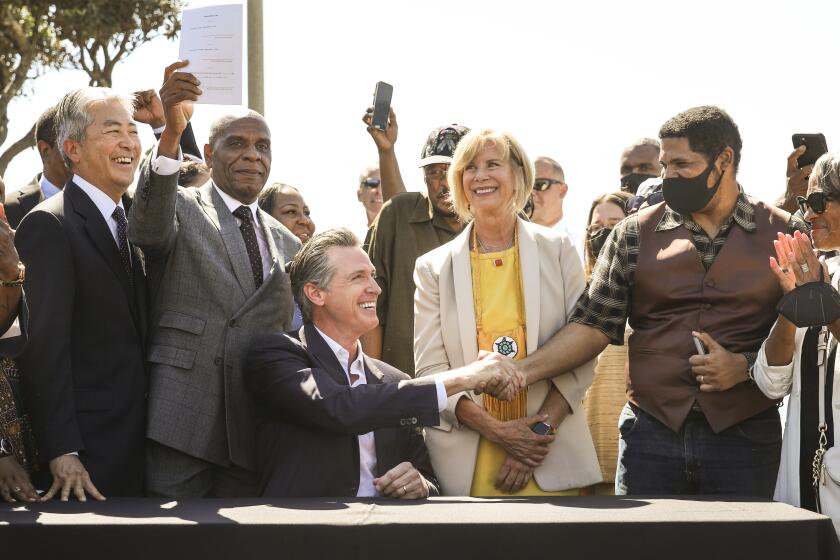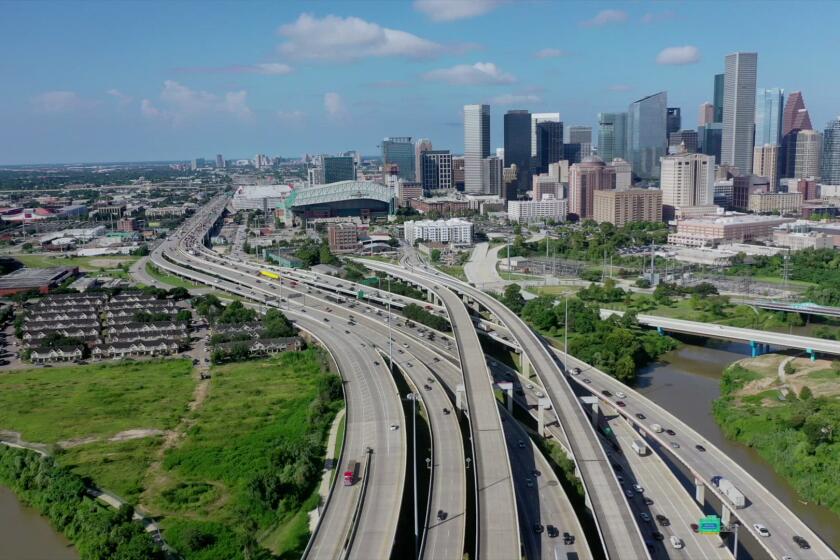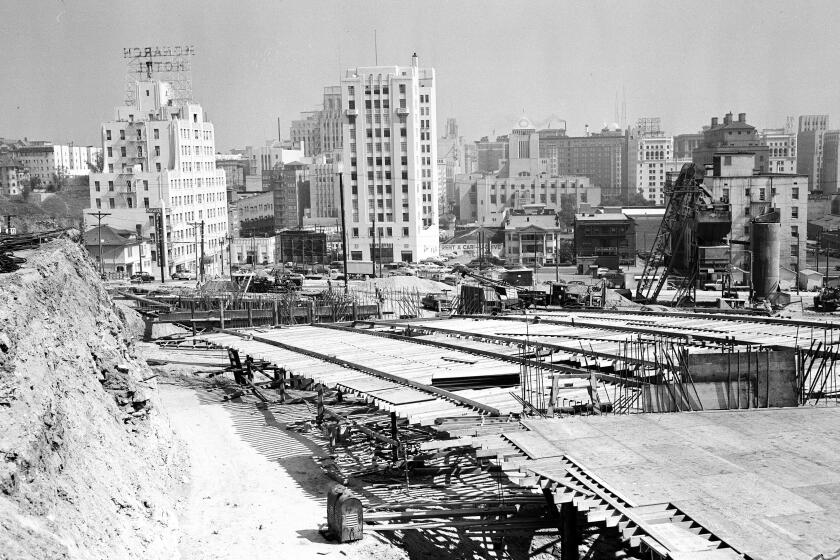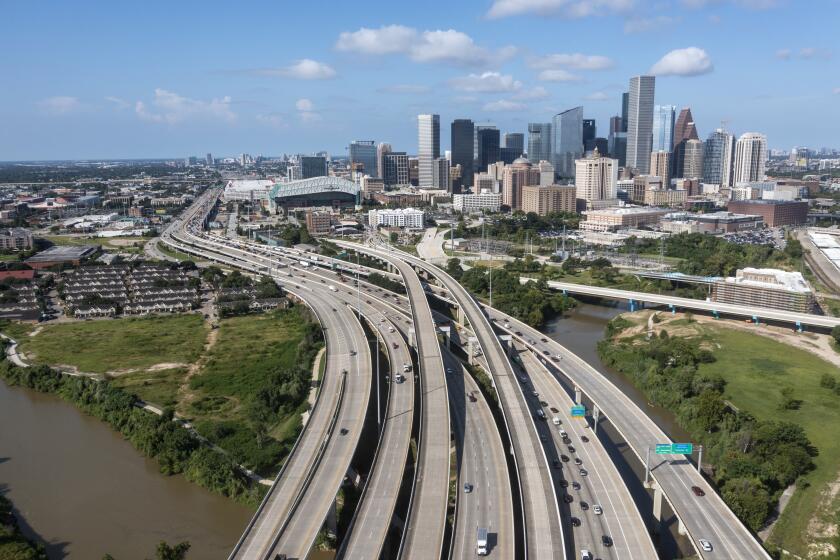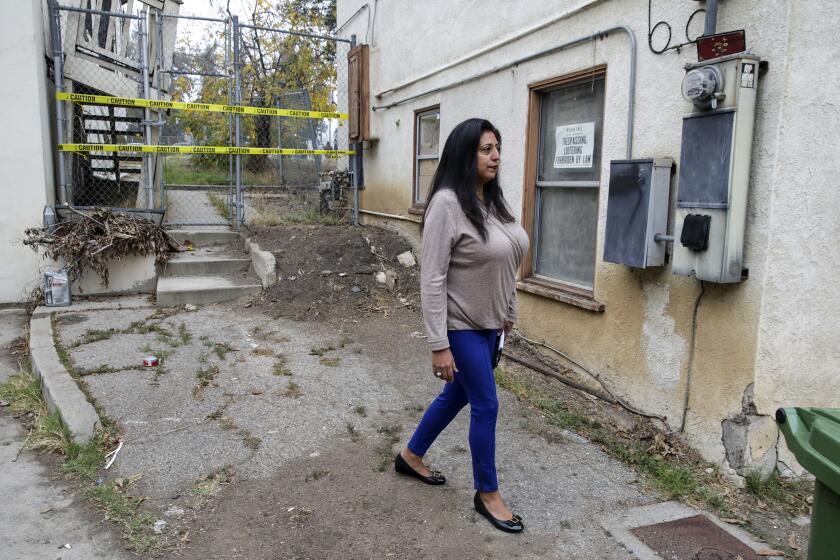Santa Monica’s message to people evicted long ago for the 10 Freeway: Come home

Nichelle Monroe’s ties to Santa Monica run deep.
Her great-uncle is said to have been the first Black baby born there more than a century ago. Apartments and other buildings in the beachfront city were designed by her architect grandfather, Vernon Brunson.
Monroe remembers when her grandparents would drive her by the intersection of 20th Street and Michigan Avenue and point up an alleyway to where their duplex used to be.
In that spot today looms the 10 Freeway, which cut through Santa Monica’s Pico neighborhood as it was built to stretch to the Pacific. Monroe’s grandparents, along with about 600 other predominately Black families, lost their homes.
More than half a century later, Santa Monica is offering a chance for some of them to come back. Starting in January, the city will offer affordable housing to those forced out by freeway construction and those removed in the late 1950s when the city bulldozed another Black area, Belmar Triangle, to build the Santa Monica Civic Auditorium. Children and grandchildren of those who lost their homes also are eligible.
Santa Monica’s act of civic penance is an attempt to recognize the harm done to largely Black communities during the post-World War II era of freeway building and urban renewal.
The program is part of a nationwide movement to compensate residents for racist harms related to housing and property. The efforts gained momentum after the murder of George Floyd in spring 2020.
In September, California Gov. Gavin Newsom signed a law that authorized the return of shorefront land known as Bruce’s Beach to the descendants of a Black couple who were run out of Manhattan Beach nearly a century ago.
Gov. Gavin Newsom authorizes returning the land known as Bruce’s Beach to the descendants of a Black couple that had been run out of Manhattan Beach.
Earlier this year, Evanston, Ill., became the nation’s first city to create an explicit reparations program, providing Black residents who faced housing discrimination through much of the 20th century or their descendants money for down payments or home repairs.
For Monroe, the building of the freeway left a family wound that has never fully healed.
“If you had something and you lost it due to eminent domain, due to racism, you’re thinking about it and it affects your every move thereafter,” said Monroe, who lives in a one-bedroom duplex in Alhambra. “It’s almost like PTSD. It affects how you think of yourself in society, what you believe is possible in that society.”
Some of the country’s largest recent highway expansions have inflicted another round of displacement in largely Black and Latino communities.
Nationwide, more than 1 million people lost their homes in just the first two decades of interstate construction alone. Early on, highway planners targeted many Black neighborhoods for destruction, and displaced families often received little compensation.

The legacy of those decisions remains in tourist-friendly Santa Monica. Fewer Black people live in the city today than in 1960, before the freeway was built. Those pushed out say people they meet often are surprised to hear Santa Monica used to have a robust Black community.
The city program initially will be open to 100 displaced families or their descendants who earn limited incomes, giving them priority access to apartments with below-market rents. But city leaders hope their efforts will grow into a national model to address past racist policies.
Construction of the U.S. Interstate Highway System tore through the nation’s urban areas with freeways that, through intention and indifference, carved up Black communities
“We will be able to right a historic wrong,” said Santa Monica City Councilwoman Kristin McCowan. “Eventually, we’re going to do that for more and more people. And if other communities start to do their share, you can see a real tidal wave potentially across the country.”
Santa Monica officials say they realize the program cannot make up for what was taken.
Renters got nothing when they were forced out; only their landlords did. Homeowners lost the ability to earn the generational wealth from owning property near the Southern California coastline.
Before the 10 Freeway, many children in the Pico neighborhood walked to school together, gathering their friends along the way. At night, their parents would grab hamburgers at a drive-in restaurant, playing Ella Fitzgerald and Johnny Otis on the jukebox. Afterward, they danced at the Marimba nightclub on Olympic Boulevard.
Mostly blue-collar Mexican American and Black families lived as neighbors in cottages, Spanish-style bungalows and apartment complexes. Many Black residents came to Pico from the Deep South to escape brutal segregation.
To report on people who have lost their homes because of highway projects in the modern era, The Times analyzed data submitted by states to the Federal Highway Administration each year since 1991.
“That was our little community,” said Evelyn Whitaker, who was in high school when the freeway took both her mother’s and grandmother’s homes. “It was only grand because we made it grand. With our friends and our family and the people we loved.”
As the 10 Freeway’s path to the sea was being developed, Santa Monica civic boosters pushed for their city to be its terminus, believing publicity from the name “the Santa Monica Freeway” would be a boon.
But business interests wanted to protect commercial and industrial land nearby, so planners sliced through Pico — a decision they justified because property values were lower there, a fact fueled by government-backed mortgage redlining policies that discouraged investment in areas with large poor or nonwhite populations.
“It’s not like they say, ‘We’re chasing out all the Black people. We’re chasing out all the low-income people,’” said Alison Rose Jefferson, a scholar in residence at the Getty Conservation Institute who has written a history of the Black experience in Santa Monica. “But it tells you they’re not valuing these people.”
Some Pico residents stood in front of bulldozers. The NAACP pleaded for an alternative that didn’t displace so many Black families.
Minnie Duncan McCauley was a toddler when her folks brought her to a sleepy little country town called Santa Monica.
A survey of homeowners along the freeway route at the time found that the average family had lived on its property for more than 17 years. And because the families received little for their homes, it was hard to buy elsewhere in Santa Monica.
Fair housing activists went door to door in 1966 polling apartment managers in white neighborhoods to see whether they would rent to Black residents. Only one out of 27 said he would. When a Black family attempted to integrate a white community a few years earlier, two Molotov cocktails were thrown onto their front porch.
Whitaker’s mother ended up buying a home in South Los Angeles, joining many Black families there.
“We moved where my mother’s money could take her,” Whitaker said.
Whitaker owns a home in Baldwin Hills and won’t return to Santa Monica under the new housing program. But she often thinks about how much of a difference owning land in the affluent city would have meant for her family.
“I do think about my mother’s property there, what it could have been worth at this time and all the opportunities that are there in Santa Monica,” Whitaker said. “The opportunities were not there for Black people. What hurts me the most is when I think about if everyone started with an even playing field, how wonderful that would be.”
City and state officials unveiled a plan Friday to acquire 77 parcels from the California Department of Transportation and build affordable housing and parks in El Sereno where the 710 Freeway was once supposed to go.
Santa Monica’s program is similar to one in Portland, Ore., that began six years ago and offers preference in the city’s affordable housing programs to families and descendants forced from a historically Black neighborhood by the construction of Interstate 5 and urban redevelopment.
Through redlining, exclusionary zoning, racially restrictive covenants and displacement caused by freeways and redevelopment, nearly every urban area in the country prevented Black families from accessing the same wealth and opportunity available to white residents and their children, said Sheryll Cashin, a law professor at Georgetown University and author of “White Space, Black ‘Hood: Opportunity Hoarding and Segregation in the Age of Inequality.”
In light of this history, Santa Monica’s effort makes sense, she said.
“It’s an example of more of what needs to happen where a city looks honestly at its past to understand that a lot of the dramatic inequality in the present overlays with race,” Cashin said.
Discussions about the housing program began in 2019 when Santa Monica officials were deciding how to commemorate the city’s historic Black communities during the construction of an athletic field in what was once Belmar Triangle. A walking path around the field now features photos of Santa Monica’s early Black families and signs describe how the freeway and urban renewal projects destroyed neighborhoods.
Historian Alison Rose Jefferson takes us on a tour of what remains of Santa Monica’s once tight-knit Black community, decimated by racist policies.
Ultimately, the City Council decided to give families that were forced out preferential treatment on its waitlist for low-income apartments.
To qualify, residents must prove that they or their families were displaced and meet income requirements, generally earning no more than $66,250 for a single person or $94,600 for a family of four. They would get apartments with rents now restricted at $1,891 a month for a one-bedroom through $2,896 for a four-bedroom — amounts far less than what you could find on the open market.
But in a sign of how hard affordable housing is to come by, the current waitlist extends to more than 6,000 families. Low-income households living in Santa Monica that are evicted when their rent-controlled apartments are demolished or when other actions cause immediate displacement will have the first option to receive housing.
Nevertheless, city officials are confident that the program will provide opportunities for dozens of families displaced by the construction of the 10 Freeway or the Civic Auditorium to find homes.
Monroe could be one of them.
When the freeway took her grandparents’ duplex, they moved to another property they owned in Santa Monica.
On that land, Monroe’s grandfather designed a two-story house with five apartments in the back. For years, the family centered its life there, and it remained Monroe’s base for holidays and summers even after she and her parents moved to Mississippi when she was 10.

Monroe returned to attend Santa Monica College, where she now works, and lived in one of her grandparents’ apartments. But 15 years ago, after her grandparents’ death, a relative sold the property and Monroe’s physical link to Santa Monica was severed, even if the emotional connection never faded.
“Everywhere that I’ve been,” Monroe said, “no place compares to my beloved Santa Monica.”
Monroe said she has mixed feelings about the new housing program and the city’s other recent efforts to recognize Black history. Monroe believes the city should be making it easier for her family to actually buy a home in the community.
She’s proud photos of her grandparents and great-grandparents are featured in the new Belmar Triangle walking path.
“But what else is there?” Monroe said. “The theft is still there. The generational wealth is still gone.”
More to Read
Sign up for Essential California
The most important California stories and recommendations in your inbox every morning.
You may occasionally receive promotional content from the Los Angeles Times.

